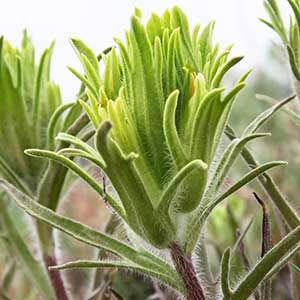Castilleja viscidula
Castilleja oresbia
sticky Indian paintbrush, sticky paintbrush
pale paintbrush, pale Wallowa Indian paintbrush, pale Wallowa paintbrush
several, ascending to erect, decumbent at base, unbranched, sometimes branched, hairs spreading, long, soft, mixed with shorter stipitate-glandular ones.
few to several, erect or ascending, sometimes decumbent at base, unbranched or branched, hairs usually retrorse, medium length, ± soft, eglandular, mixed with very short-glandular ones, sometimes with spreading, long, soft ones.
green to brown, linear, linear-lanceolate, lanceolate, or oblong (narrowly ovate nearing inflorescence), 1–4(–5) cm, not fleshy, margins wavy, flat or involute, (0–)2(–5)-lobed, apex acute;
lobes ascending-spreading, oblong to narrowly lanceolate, apex acute or obtuse.
green to purple, linear to lanceolate, 2–7 cm, not fleshy, margins plane, involute, 3–5(–7)-lobed, apex acuminate to acute;
lobes spreading, linear to sometimes narrowly lanceolate, apex acute.
2–14 × 1–3.5 cm;
bracts proximally greenish to greenish brown, distally pale yellow, cream, or yellow-green, sometimes yellow-orange or red (sometimes gradually differentiated from proximal coloration), lanceolate, broadly lanceolate, or oblong, 3(–5)-lobed, proximal wavy-margined;
lobes ascending, linear to narrowly lanceolate, long, arising near or above mid length, sometimes wavy-margined, apex acute to rounded.
2.5–18 × 1–3.5 cm;
bracts pale green to yellow-green or pale, dull reddish brown throughout, or proximally so colored but changing gradually to cream or yellowish on distal margins, narrowly to broadly lanceolate, (3–)5–7(–9)-lobed;
lobes ascending, linear, long, proximal lobes arising below mid length, central lobe apex obtuse, others acute.
straight, 16–22(–25) mm;
tube 10–15 mm;
beak exserted, straight to sometimes curved, adaxially green to yellow, 5–8(–9) mm;
abaxial lip green or yellow, sometimes deep purple, reduced, inconspicuous, often visible in abaxial cleft, 1–2 mm, 20% as long as beak;
teeth erect, green to white, sometimes yellow or pink, 0.5–1 mm.
straight, 21–36 mm;
tube 16–20 mm;
teeth of abaxial lip often exserted, beak exserted;
beak adaxially green, 4.2–5.5 mm;
abaxial lip green to purple, distally white, conspicuous, slightly but noticeably pouched, often visible through front cleft, 3–5 mm, 67–100% as long as beak, puberulent;
teeth erect, white, 1.8–2.1 mm.
colored as bracts or proximally paler, (10–)14–18 mm;
abaxial and adaxial clefts (4–)5–9 mm, 30–40% of calyx length, deeper than laterals, lateral (1–)2–6 mm, ca. 25% of calyx length;
lobes narrowly ovate to lanceolate, linear, or narrowly lanceolate, apex acute to obtuse.
colored as bracts, 10–25 mm;
abaxial and adaxial clefts 6–7 mm, 30–60% of calyx length, deeper than laterals, lateral 5–10 mm, 40–50% of calyx length;
lobes linear, apex acute.
= 24, 72.
Castilleja viscidula
Castilleja oresbia
Castilleja viscidula is a member of the complex including C. applegatei and C. martini, centered in California. Castilleja viscidula favors isolated mountain ranges, from the Wallowa and, possibly, the Blue mountains of northeastern Oregon, eastward into southwestern Idaho, and southward into central Nevada. Most populations are greenish yellow, but in one portion of the Wallowa Mountains, reddish bracted plants are common. Many yellowish bracted populations in the same mountain range surround this reddish population. Intermediate color forms are rarely encountered. Most ranges where C. viscidula occurs have generated slightly differing local races, demonstrating some reproductive isolation and divergence. In addition, hybrid swarms between this species and C. nana are known from several mountain ranges in central and northern Nevada, and an apparent hybrid with C. flava var. flava is known from the Independence Mountains of northern Nevada.
(Discussion copyrighted by Flora of North America; reprinted with permission.)
Castilleja oresbia is endemic to eastern Oregon and adjacent Idaho. It is easily confused with both varieties of C. pallescens, which also occur in sagebrush habitats. Castilleja oresbia has longer calyx lobes and softer pubescence than C. pallescens var. pallescens, although some transitional specimens are found. Castilleja oresbia has a combination of longer calyx lobes, longer pubescence, and obscurely nerved bracts, which usually serve to separate it from C. pallescens var. inverta. All three have different, though somewhat overlapping, ranges. Castilleja oresbia occasionally hybridizes with C. peckiana in Grant County, Oregon.
(Discussion copyrighted by Flora of North America; reprinted with permission.)


